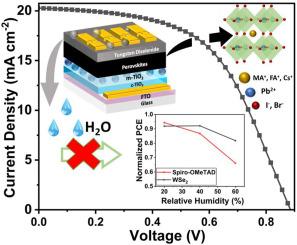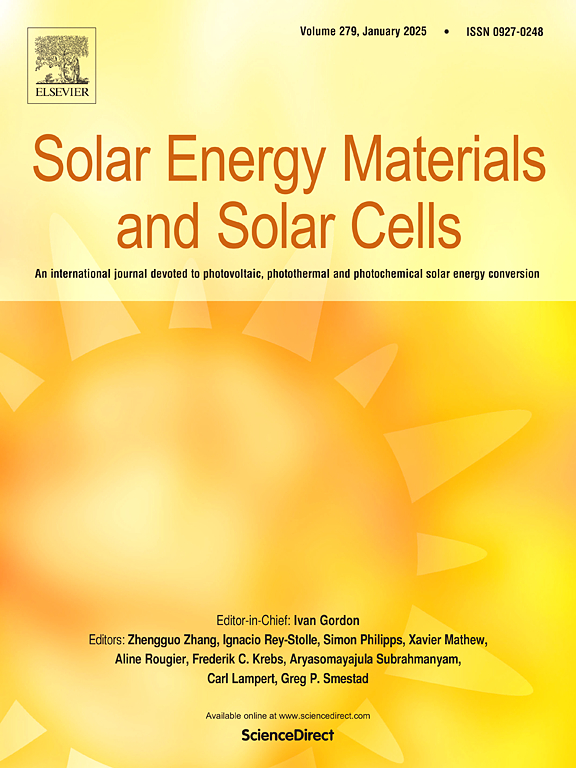Solution-processed tungsten diselenide as an inorganic hole transport material for moisture-stable perovskite solar cells in the n-i-p architecture
IF 6.3
2区 材料科学
Q2 ENERGY & FUELS
引用次数: 0
Abstract
Some of the obstacles to the commercialization of perovskite solar cells (PSCs) are their long-term moisture stability and material cost of the constituent layers, such as the commonly used spiro-OMeTAD hole transport layer (HTL). Replacing the spiro-OMeTAD with low-cost inorganic hole transport materials (HTMs) are important to further elevate the attractiveness of PSCs for commercialization. Perovskite-compatible, solution-exfoliated two-dimensional (2D) transition metal dichalcogenides (TMDCs) are being considered as viable candidates for inorganic HTMs. We consider one such TMDC, WSe2 which was chemically exfoliated using dichlorobenzene (DCB), a perovskite-compatible solvent, as it was integrated with triple cation perovskite absorbers within the solar cell stack. The WSe2 HTL required heat treatment processes to be maintained below 100 °C in order to preserve the integrity of the underlying perovskite; despite this lower temperature post treatment process, the structural morphology of the film revealed its dense and pinhole-free nature. Temperature-dependent transport studies conducted on the WSe2 film provided evidence of its semiconducting character and its ability to extract holes well from the underlying triple-cation Cs0.05FA0.79MA0.16PbI2.45Br0.55 absorber. The inorganic HTL offered better environmental stability in moisture-rich environments of up to 60 % relative humidity, in comparison to spiro-OMeTAD HTL-based devices which degraded faster as a result of pinholes.

溶液处理的二硒化钨作为湿稳定性钙钛矿太阳能电池的无机空穴传输材料
钙钛矿太阳能电池(PSCs)商业化的一些障碍是其长期的水分稳定性和组成层的材料成本,例如常用的spiro-OMeTAD空穴传输层(HTL)。用低成本的无机空穴传输材料(HTMs)取代spiro-OMeTAD对于进一步提高psc的商业化吸引力非常重要。钙钛矿相容、溶液剥离的二维(2D)过渡金属二硫族化合物(TMDCs)被认为是无机HTMs的可行候选材料。我们考虑了一种这样的TMDC, WSe2,它是用二氯苯(DCB)化学剥离的,一种钙钛矿兼容的溶剂,因为它与太阳能电池堆中的三阳离子钙钛矿吸收剂集成在一起。WSe2 HTL要求热处理过程保持在100℃以下,以保持底层钙钛矿的完整性;尽管采用了这种较低温度的后处理工艺,但薄膜的结构形貌显示出致密和无针孔的性质。在WSe2薄膜上进行的温度依赖输运研究证明了其半导体特性和从其下的三阳离子Cs0.05FA0.79MA0.16PbI2.45Br0.55吸收剂中提取孔洞的能力。无机HTL在相对湿度高达60%的富湿环境中提供了更好的环境稳定性,而基于spiro-OMeTAD的HTL设备由于针孔而退化得更快。
本文章由计算机程序翻译,如有差异,请以英文原文为准。
求助全文
约1分钟内获得全文
求助全文
来源期刊

Solar Energy Materials and Solar Cells
工程技术-材料科学:综合
CiteScore
12.60
自引率
11.60%
发文量
513
审稿时长
47 days
期刊介绍:
Solar Energy Materials & Solar Cells is intended as a vehicle for the dissemination of research results on materials science and technology related to photovoltaic, photothermal and photoelectrochemical solar energy conversion. Materials science is taken in the broadest possible sense and encompasses physics, chemistry, optics, materials fabrication and analysis for all types of materials.
 求助内容:
求助内容: 应助结果提醒方式:
应助结果提醒方式:


